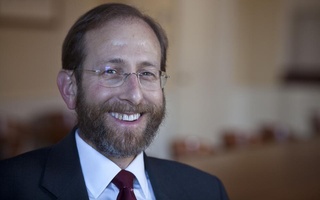
An illustration representing the changing future of Harvard relations with Allston that come with changes in leadership.
On the Friday morning in April when his appointment as Provost was announced, Alan M. Garber ’76 spoke in subdued tones as he discussed his thoughts on succeeding Steven E. Hyman. But Garber lit up with excitement—the corners of his mouth tugging up into a small smile—as he touched on the possibilities associated with Harvard’s expansion in Allston.
With a medical degree and a Ph.D. in economics, Garber—a Stanford professor who will assume the Provost position at the end of this academic year—says he is particularly excited to spearhead Harvard’s development in Allston, a place where Harvard’s wide breadth of science resources could centralize and flourish through interdisciplinary work.
“One of the biggest attractions of this job is the ability to participate in the future of the Allston campus,” Garber said at the time. “I view Allston as an opportunity unlike any other in American higher education today, where there is a campus that can be used to help realize the University’s vision for the future and make this a truly 21st century university.”
Despite his optimism, Garber will take up his post facing a historically difficult relationship between the University and the neighborhood and a future in which Harvard, having learned from the financial crisis, must proceed cautiously. While Garber has previously said that spearheading the University’s Allston planning is one of the most exciting aspects of the provost position, he was unable to elaborate on his vision for Allston.
Despite spending the past 25 years at Stanford, Garber will be at home at Harvard. He is a summa cum laude graduate who studied Economics at the College. He went on to receive his Ph.D. in Economics from Harvard and an M.D. from Stanford. During his time on the Stanford faculty, Garber’s academic work has focused mainly on health policy economics, but he has also served on a Harvard Medical School and Harvard Dental School visiting committee.
Garber’s colleagues, both those past at Stanford and future at Harvard, say they believe his accomplishments on the west coast will give him the momentum to bring the sciences to Allston, though it will be a challenging project.
A DIFFICULT PAST
During the late 1980s and early 1990s, Harvard purchased 52.6 acres of land in Allston under a subsidiary of a different name, with plans to expand the University’s campus across the river.
In 1997, Allston residents discovered Harvard’s stealthy purchases of land, sparking tensions between the neighborhood and the University. But in 2003, the University revealed its plans for a portion of its land-holdings; Lawrence H. Summers, Harvard’s president at the time, announced that the University would build the Allston Science Complex on a large plot of land on Western Avenue, behind the Harvard Business School. Four years of community meetings and strategic planning followed.
In 2007, the Boston Redevelopment Authority fast-tracked the plan for approval, and the following year the University broke ground on the site.
But Harvard was only able to construct the foundation of the complex. Following, the financial crisis in the Fall of 2008, Harvard announced it was slowing construction on the site in Feb. 2009 and halted it completely that December. The plot of land on Western Avenue that was meant to be a vibrant center for stem cell research is now a paved-over foundation—a building project indefinitely on hold—surrounded by a fence and University-subsidized shrubbery. In the wake of the halt on construction, Harvard University President Drew G. Faust promised a three-part plan that would develop Allston in other ways: leasing and improving vacant property, engaging the community, and developing Harvard’s campus when feasible.
Harvard asserts that it has made good on the first two portions of this plan, having leased over 118,000 square feet of land to 12 businesses and nonprofit organizations in the past six months.
The leases include an all-you-can-eat sushi restaurant, a boxing club, a swiss bakery, and most recently a dance studio, Mass Motion. Many residents say they are excited that vacant lands will soon spur activity, but other community members note that they feel the businesses will not provide them with everyday necessities that have been lost since Harvard began buying up property in the neighborhood.
“We had a community master-plan and this is what we’re getting—we’re getting restaurants,” says Paul Berkeley, the president of the Allston Civic Association, recalling the loss of retail outlets, such as Kmart and OfficeMax.
Others say that while bringing businesses to Allston is beneficial to the local economy, it does not compare to the number of jobs that the construction and presence of the Science Complex would have provided the neighborhood. Furthermore, Harvard’s original proposals for Allston reveal a plan to make the neighborhood a cultural center, with the possibility of transporting some of the University’s museums across the river.
Read more in News
Renaissance EngineeringRecommended Articles
-
 Stanford Professor Alan M. Garber ’76 Selected as Next Provost
Stanford Professor Alan M. Garber ’76 Selected as Next Provost -
 Professors Confident in New Provost
Professors Confident in New Provost -
Hyman Leads Stanley CenterPrior to becoming director of the Center, Hyman served as director of the National Institute of Mental Health in the 1990s, which helped fuel his interest in the problems posed by serious mental illnesses.
-
 The Fall of Academics at Harvard
The Fall of Academics at Harvard -
Students To Vote on Reintroducing American Sign Language CoursesStarting on April 21, undergraduates will be able to vote on whether or not to support the reintroduction of American Sign Language courses that may be taken for credit.
-
 Sign Language Referendum Passes Easily Amid Low Voter Turnout
Sign Language Referendum Passes Easily Amid Low Voter Turnout













